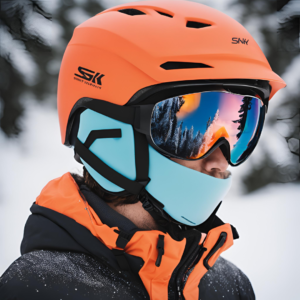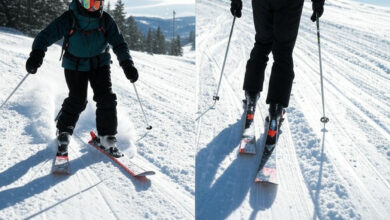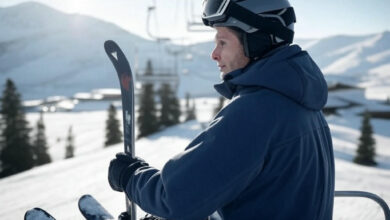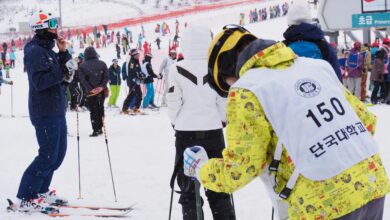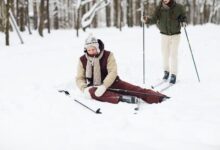What to Wear Under Your Ski Helmet to Keep Warm in 2024
Introduction to Ski Helmet Headwear: Stay Warm on the Slopes
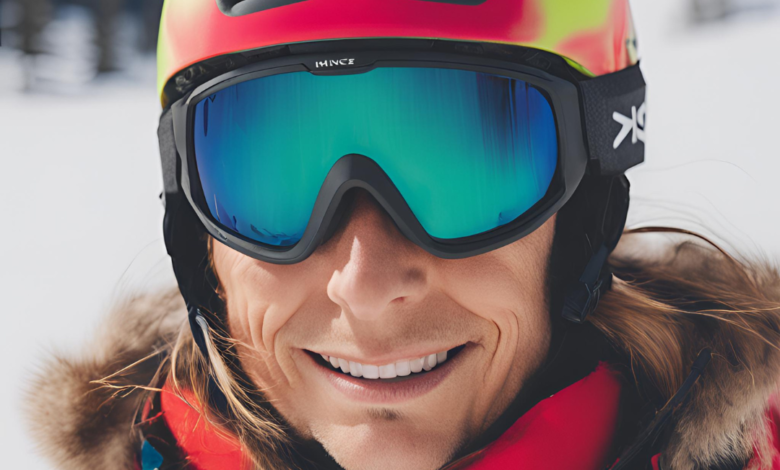
Contents
- 1 Introduction
- 2 Why Keeping Your Head Warm is Important
- 3 Factors to Consider When Choosing Headwear
- 4 Best Options for Headwear Under a Ski Helmet
- 5 Layering Techniques
- 6 Practical Tips for Staying Warm
- 7 Conclusion
Ski Helmet to Keep Warm
As winter approaches, skiing enthusiasts prepare for thrilling adventures on the slopes. One crucial aspect of preparation is knowing what to wear under your ski helmet to keep warm. Proper ski helmet headwear not only ensures comfort but also enhances safety by maintaining optimal body temperature. Whether you’re looking for the best headwear for skiing, exploring different skiing headwear options, or seeking advice on materials like merino wool, synthetic fabrics, and fleece, this guide will provide you with comprehensive insights. Stay warm and enjoy your skiing experience with the right gear under your ski helmet.
Introduction
Skiing combines the thrill of speed with the beauty of snowy landscapes, but it also exposes you to harsh winter conditions. The cold wind and frigid temperatures can quickly sap your body heat, especially from your head, which is highly susceptible to heat loss. Wearing a ski helmet is essential for protection, but without the right underneath layers, you might still feel the chill. In this guide, we will explore various options and considerations for headwear that fits comfortably under your ski helmet, ensuring you stay warm and focused on enjoying your skiing adventure.
Why Keeping Your Head Warm is Important
Keeping your head warm while skiing is crucial for several reasons:
- Heat Retention: Your head loses heat faster than any other part of your body, making it vital to insulate it properly.
- Comfort: A cold head can make you uncomfortable, affecting your concentration and enjoyment.
- Safety: Staying warm helps maintain your overall body temperature, reducing the risk of hypothermia.
- Performance: Warmth can improve your performance by ensuring you’re not distracted by the cold.
Factors to Consider When Choosing Headwear
When selecting what to wear under your ski helmet, consider the following factors:
Material
The material of your headwear is crucial for warmth, comfort, and moisture management. Look for materials that provide insulation while wicking away sweat.
- Merino Wool: Known for its excellent thermal properties and moisture-wicking abilities, merino wool is soft, breathable, and keeps you warm without overheating.
- Synthetic Fabrics: Materials like polyester and nylon are good at wicking moisture and drying quickly. They are also lightweight and can provide adequate insulation.
- Fleece: Fleece is a popular choice for its warmth and softness. It is also breathable and dries quickly, making it suitable for cold conditions.
Fit
The fit of your headwear should be snug but not too tight. It should cover your ears and forehead without creating pressure points under your helmet.
- Thin Layers: Opt for thin, form-fitting layers that can comfortably fit under your helmet without causing discomfort.
- Stretchy Materials: Fabrics with a bit of stretch can conform to the shape of your head and provide a better fit.
Breathability
Breathability is essential to prevent overheating and moisture buildup, which can lead to discomfort and chills.
- Ventilated Designs: Some headwear comes with ventilation features that allow excess heat and moisture to escape.
- Moisture-Wicking Properties: Choose materials that can wick sweat away from your skin to keep you dry.
Weather Conditions
Consider the typical weather conditions you’ll be skiing in. For extremely cold weather, you’ll need more insulation, while milder conditions may require lighter options.
Helmet Compatibility
Ensure that the headwear you choose is compatible with your ski helmet. It should not interfere with the helmet’s fit or safety features.

Best Options for Headwear Under a Ski Helmet
Balaclavas
Balaclavas are a popular choice for skiers because they provide full coverage for your head, neck, and sometimes even your face. They come in various materials and thicknesses to suit different weather conditions.
Benefits of Balaclavas
- Full Coverage: Balaclavas cover your head, neck, and face, providing excellent protection against the cold.
- Versatility: They can be worn in different ways, such as a full-face mask, neck gaiter, or hat.
- Layering: Thin balaclavas can be easily layered under your helmet without adding bulk.
Recommended Materials
- Merino Wool Balaclavas: Ideal for cold weather, providing warmth and moisture-wicking properties.
- Synthetic Balaclavas: Good for varying conditions, offering breathability and quick drying.
Beanies and Skull Caps
Beanies and skull caps are simple yet effective options for headwear under your ski helmet. They provide insulation and are easy to layer.
Benefits of Beanies and Skull Caps
- Simplicity: Easy to put on and take off, and they fit well under most helmets.
- Variety: Available in various materials and thicknesses to suit different needs.
- Breathability: Many options are designed to wick moisture and allow for airflow.
Recommended Materials
- Fleece Beanies: Warm and comfortable, suitable for very cold conditions.
- Merino Wool Caps: Provide warmth and moisture management without bulk.
- Synthetic Skull Caps: Lightweight and breathable, ideal for milder conditions.
Headbands and Ear Warmers
For skiers who find full head coverage uncomfortable, headbands and ear warmers are great alternatives. They keep your ears warm while allowing heat to escape from the top of your head.
Benefits of Headbands and Ear Warmers
- Targeted Warmth: Keeps your ears warm without overheating your head.
- Comfort: Less restrictive than full head coverings.
- Layering: Can be used in combination with other headwear for added warmth.
Recommended Materials
- Fleece Ear Warmers: Soft and insulating, perfect for cold days.
- Merino Wool Headbands: Warm and breathable, suitable for various conditions.
- Synthetic Ear Warmers: Lightweight and moisture-wicking, good for active skiing.
Neck Gaiters and Buffs
Neck gaiters and buffs are versatile accessories that can be worn in multiple ways, including as a head covering. They provide additional warmth and can be adjusted as needed.
Benefits of Neck Gaiters and Buffs
- Versatility: Can be worn as a neck warmer, face mask, or head covering.
- Adjustability: Easy to adjust to different levels of coverage and warmth.
- Layering: Can be used in conjunction with other headwear for added protection.
Recommended Materials
- Merino Wool Buffs: Warm and breathable, ideal for layering.
- Synthetic Gaiters: Lightweight and quick-drying, suitable for active use.
- Fleece Gaiters: Extremely warm and comfortable for very cold conditions.
Layering Techniques
Layering is a key strategy for staying warm while skiing. By combining different types of headwear, you can customize your insulation to match the weather conditions and your activity level.
Base Layer
Start with a thin, moisture-wicking base layer that fits snugly against your head. This layer helps to manage sweat and keep you dry.
- Examples: Thin merino wool cap, synthetic skull cap.
Mid Layer
Add a mid layer for additional warmth. This layer should be slightly thicker but still breathable.
- Examples: Fleece beanie, merino wool balaclava.
Outer Layer
In extremely cold or windy conditions, you might need an outer layer for maximum protection. This layer should provide wind resistance and extra insulation.
- Examples: Thick fleece balaclava, insulated headband.
Adjustable Layers
Consider using adjustable layers like neck gaiters or buffs that can be easily removed or repositioned as needed.
Practical Tips for Staying Warm
Avoid Overheating
While it’s important to stay warm, overheating can lead to sweating, which can make you colder in the long run. Choose breathable materials and adjust your layers based on your activity level and the weather conditions.
Keep Dry
Moisture management is crucial. Wet fabric loses its insulating properties and can make you feel colder. Choose moisture-wicking materials and change out of wet gear as soon as possible.
Cover Exposed Skin
Make sure to cover any exposed skin, especially in very cold or windy conditions. Use balaclavas or buffs to cover your face and neck.
Fit Matters
Ensure that all your headwear layers fit comfortably under your helmet without causing pressure points. A proper fit is essential for both comfort and safety.
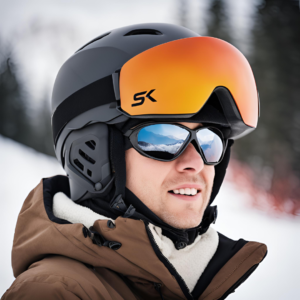
Test Your Gear
Before hitting the slopes, test your headwear combinations in cold conditions to ensure they provide the warmth and comfort you need.
Conclusion
Staying warm while skiing is essential for both comfort and safety. By carefully choosing the right headwear to wear under your ski helmet, you can enjoy your time on the slopes without worrying about the cold. Consider the material, fit, and breathability of your headwear, and use layering techniques to customize your warmth. Whether you prefer a balaclava, beanie, headband, or neck gaiter, there are plenty of options to keep you warm and comfortable under your ski helmet. Remember to stay dry, avoid overheating, and test your gear to ensure the best skiing experience. With the right preparation, you can focus on the thrill of the sport and the beauty of the winter landscape.

